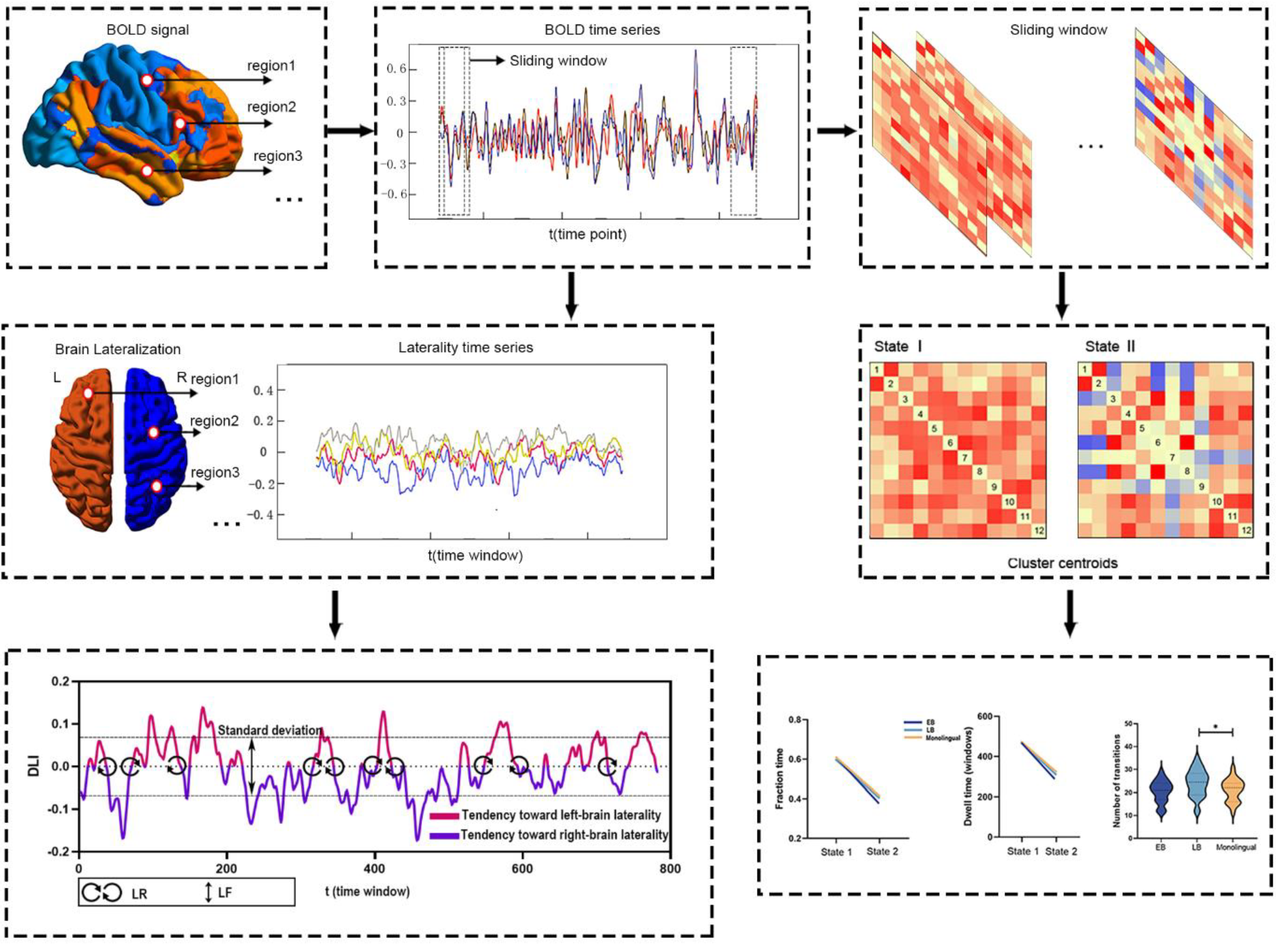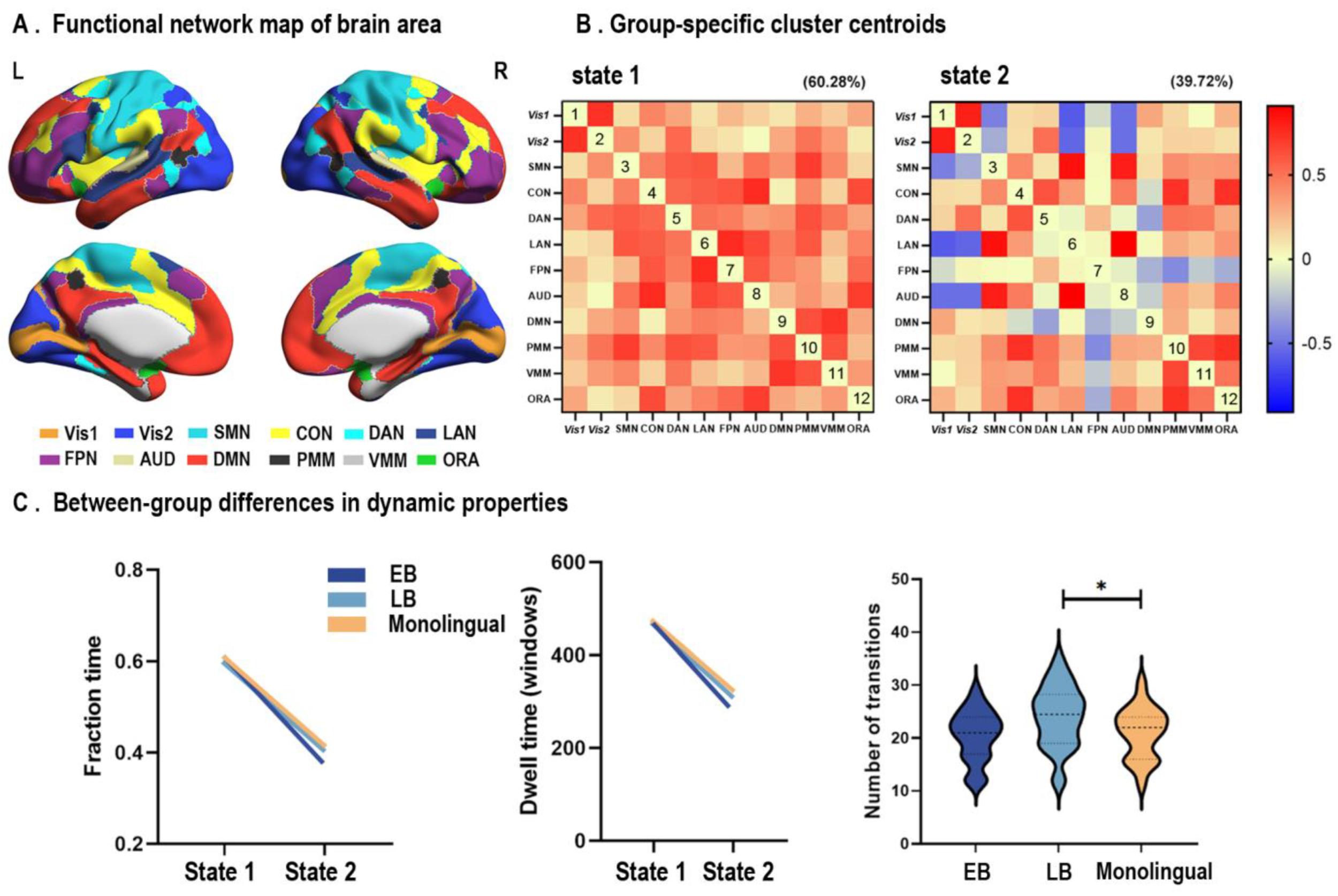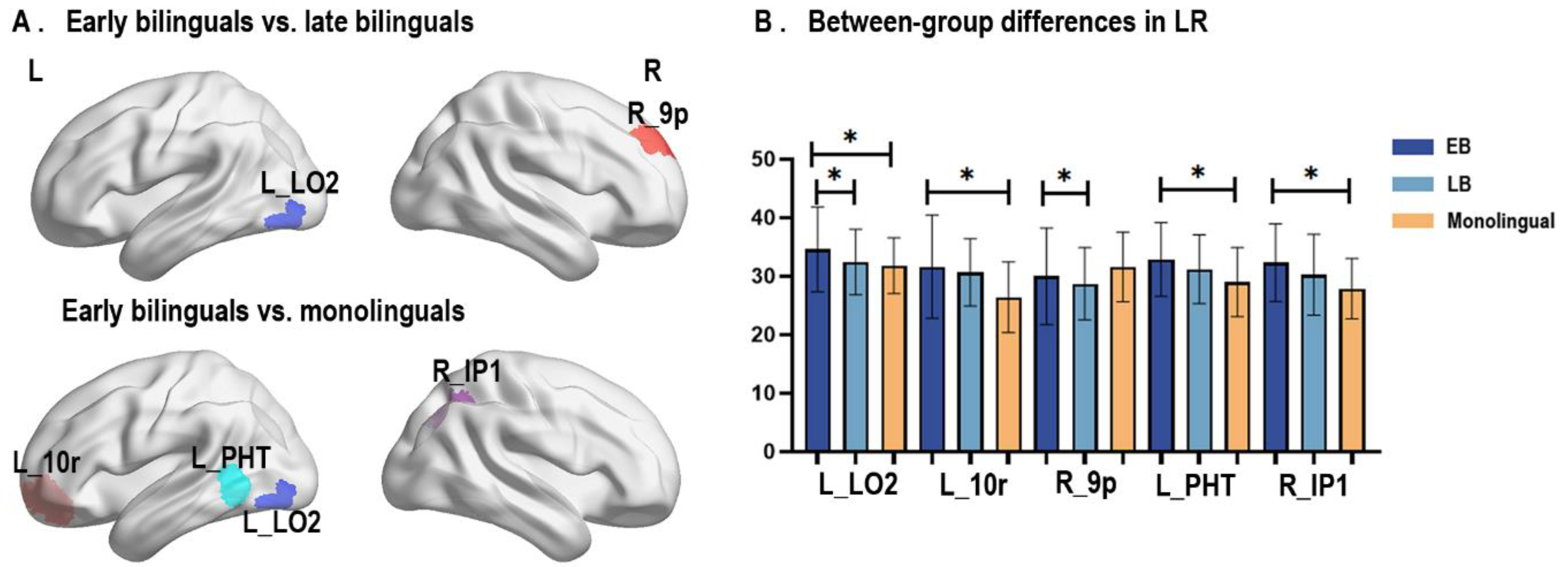Age of Bilingual Onset Shapes the Dynamics of Functional Connectivity and Laterality in the Resting-State
Abstract
:1. Introduction
2. Materials and Methods
2.1. Participants
2.2. MRI Acquisition
2.3. Preprocessing
2.4. Dynamic Functional Connectivity
2.5. Dynamic Laterality
2.6. Statistical Analysis
3. Results
3.1. Demographic Analysis
3.2. Clustering-Based Analysis
3.3. Dynamic Laterality of the Cortex
3.4. Correlation between Dynamic Measures and L2 Proficiency
4. Discussion
5. Conclusions
Author Contributions
Funding
Institutional Review Board Statement
Informed Consent Statement
Data Availability Statement
Conflicts of Interest
References
- Diamond, B.J.; Shreve, G.M. Neural and physiological correlates of translation and interpreting in the bilingual brain. Transl. Cogn. 2010, 15, 289–321. [Google Scholar]
- Carlson, S.M.; Meltzoff, A.N. Bilingual experience and executive functioning in young children. Dev. Sci. 2008, 11, 282–298. [Google Scholar] [CrossRef] [PubMed]
- Bak, T.H.; Nissan, J.J.; Allerhand, M.M.; Deary, I.J. Does bilingualism influence cognitive aging? Ann. Neurol. 2014, 75, 959–963. [Google Scholar] [CrossRef] [PubMed]
- Blom, E.; Küntay, A.C.; Messer, M.; Verhagen, J.; Leseman, P. The benefits of being bilingual: Working memory in bilingual Turkish–Dutch children. J. Exp. Child Psychol. 2014, 128, 105–119. [Google Scholar] [CrossRef]
- Bialystok, E.; Craik, F.I.; Freedman, M. Bilingualism as a protection against the onset of symptoms of dementia. Neuropsychologia 2007, 45, 459–464. [Google Scholar] [CrossRef]
- Craik, F.I.; Bialystok, E.; Freedman, M. Delaying the onset of Alzheimer disease: Bilingualism as a form of cognitive reserve. Neurology 2010, 75, 1726–1729. [Google Scholar] [CrossRef]
- Abutalebi, J.; Canini, M.; Della Rosa, P.A.; Sheung, L.P.; Green, D.W.; Weekes, B.S. Bilingualism protects anterior temporal lobe integrity in aging. Neurobiol. Aging 2014, 35, 2126–2133. [Google Scholar] [CrossRef] [PubMed]
- Schug, A.K.; Brignoni-Pérez, E.; Jamal, N.I.; Eden, G.F. Gray matter volume differences between early bilinguals and monolinguals: A study of children and adults. Hum. Brain Mapp. 2022, 43, 4817–4834. [Google Scholar] [CrossRef]
- Hartanto, A.; Yang, H. Does early active bilingualism enhance inhibitory control and monitoring? A propensity-matching analysis. J. Exp. Psychol. Learn. Mem. Cogn. 2019, 45, 360. [Google Scholar] [CrossRef]
- Luk, G.; De Sa, E.R.I.C.; Bialystok, E. Is there a relation between onset age of bilingualism and enhancement of cognitive control? Biling. Lang. Cogn. 2011, 14, 588–595. [Google Scholar] [CrossRef]
- Wei, M.; Joshi, A.A.; Zhang, M.; Mei, L.; Manis, F.R.; He, Q.; Beattie, R.L.; Xue, G.; Shattuck, D.W.; Leahy, R.M. How age of acquisition influences brain architecture in bilinguals. J. Neurolinguist. 2015, 36, 35–55. [Google Scholar] [CrossRef] [PubMed]
- Illes, J.; Francis, W.S.; Desmond, J.E.; Gabrieli, J.D.; Glover, G.H.; Poldrack, R.; Lee, C.J. Convergent cortical representation of semantic processing in bilinguals. Brain Lang. 1999, 70, 347–363. [Google Scholar] [CrossRef] [PubMed]
- Perani, D.; Paulesu, E.; Galles, N.S.; Dupoux, E.; Dehaene, S.; Bettinardi, V.; Cappa, S.F.; Fazio, F.; Mehler, J. The bilingual brain. Proficiency and age of acquisition of the second language. Brain J. Neurol. 1998, 121, 1841–1852. [Google Scholar] [CrossRef] [PubMed]
- Green, D.W.; Abutalebi, J. Language control in bilinguals: The adaptive control hypothesis. J. Cogn. Psychol. 2013, 25, 515–530. [Google Scholar] [CrossRef] [PubMed]
- Mohades, S.G.; Struys, E.; Van Schuerbeek, P.; Baeken, C.; Van De Craen, P.; Luypaert, R. Age of second language acquisition affects nonverbal conflict processing in children: An fMRI study. Brain Behav. 2014, 4, 626–642. [Google Scholar] [CrossRef] [PubMed]
- Grady, C.L.; Luk, G.; Craik, F.I.; Bialystok, E. Brain network activity in monolingual and bilingual older adults. Neuropsychologia 2015, 66, 170–181. [Google Scholar] [CrossRef] [PubMed]
- Gold, C.E. Exploring the Resting State Neural Activity of Monolinguals and Late and Early Bilinguals; Brigham Young University: Provo, UT, USA, 2018. [Google Scholar]
- Berken, J.A.; Chai, X.; Chen, J.-K.; Gracco, V.L.; Klein, D. Effects of early and late bilingualism on resting-state functional connectivity. J. Neurosci. 2016, 36, 1165–1172. [Google Scholar] [CrossRef] [PubMed]
- Sulpizio, S.; Del Maschio, N.; Del Mauro, G.; Fedeli, D.; Abutalebi, J. Bilingualism as a gradient measure modulates functional connectivity of language and control networks. NeuroImage 2020, 205, 116306. [Google Scholar] [CrossRef] [PubMed]
- Grundy, J.G.; Anderson, J.A.; Bialystok, E. Neural correlates of cognitive processing in monolinguals and bilinguals. Ann. N. Y. Acad. Sci. 2017, 1396, 183–201. [Google Scholar] [CrossRef]
- Li, L.; Abutalebi, J.; Zou, L.; Yan, X.; Liu, L.; Feng, X.; Wang, R.; Guo, T.; Ding, G. Bilingualism alters brain functional connectivity between “control” regions and “language” regions: Evidence from bimodal bilinguals. Neuropsychologia 2015, 71, 236–247. [Google Scholar] [CrossRef]
- Hutchison, R.M.; Womelsdorf, T.; Allen, E.A.; Bandettini, P.A.; Calhoun, V.D.; Corbetta, M.; Della Penna, S.; Duyn, J.H.; Glover, G.H.; Gonzalez-Castillo, J. Dynamic functional connectivity: Promise, issues, and interpretations. Neuroimage 2013, 80, 360–378. [Google Scholar] [CrossRef] [PubMed]
- Allen, E.A.; Damaraju, E.; Plis, S.M.; Erhardt, E.B.; Eichele, T.; Calhoun, V.D. Tracking whole-brain connectivity dynamics in the resting state. Cereb. Cortex 2014, 24, 663–676. [Google Scholar] [CrossRef] [PubMed]
- Spadone, S.; Della Penna, S.; Sestieri, C.; Betti, V.; Tosoni, A.; Perrucci, M.G.; Romani, G.L.; Corbetta, M. Dynamic reorganization of human resting-state networks during visuospatial attention. Proc. Natl. Acad. Sci. USA 2015, 112, 8112–8117. [Google Scholar] [CrossRef] [PubMed]
- Li, Z.; Zhao, L.; Ji, J.; Ma, B.; Zhao, Z.; Wu, M.; Zheng, W.; Zhang, Z. Temporal grading index of functional network topology predicts pain perception of patients with chronic back pain. Front. Neurol. 2022, 13, 899254. [Google Scholar] [CrossRef] [PubMed]
- Liu, G.; Zheng, W.; Liu, H.; Guo, M.; Ma, L.; Hu, W.; Ke, M.; Sun, Y.; Zhang, J.; Zhang, Z. Aberrant dynamic structure–function relationship of rich-club organization in treatment-naïve newly diagnosed juvenile myoclonic epilepsy. Hum. Brain Mapp. 2022, 43, 3633–3645. [Google Scholar] [CrossRef] [PubMed]
- Yao, Z.; Hu, B.; Xie, Y.; Zheng, F.; Liu, G.; Chen, X.; Zheng, W. Resting-state time-varying analysis reveals aberrant variations of functional connectivity in autism. Front. Hum. Neurosci. 2016, 10, 463. [Google Scholar] [CrossRef] [PubMed]
- Zhang, Q.; Zhang, W.; Zhang, P.; Zhao, Z.; Yang, L.; Zheng, F.; Zhang, L.; Huang, G.; Zhang, J.; Zheng, W. Altered dynamic functional connectivity in rectal cancer patients with and without chemotherapy: A resting-state fMRI study. Int. J. Neurosci. 2022, 1–11. [Google Scholar] [CrossRef] [PubMed]
- Zhang, Z.; Liu, G.; Zheng, W.; Shi, J.; Liu, H.; Sun, Y. Altered dynamic effective connectivity of the default mode network in newly diagnosed drug-naïve juvenile myoclonic epilepsy. NeuroImage Clin. 2020, 28, 102431. [Google Scholar] [CrossRef]
- Liu, X.; Tu, L.; Chen, X.; Zhong, M.; Niu, M.; Zhao, L.; Lu, Z.; Huang, R. Dynamic language network in early and late Cantonese–Mandarin bilinguals. Front. Psychol. 2020, 11, 1189. [Google Scholar] [CrossRef]
- Yan, C.-G.; Wang, X.-D.; Zuo, X.-N.; Zang, Y.-F. DPABI: Data processing & analysis for (resting-state) brain imaging. Neuroinformatics 2016, 14, 339–351. [Google Scholar]
- Friston, K.J.; Jezzard, P.; Turner, R. Analysis of functional MRI time-series. Hum. Brain Mapp. 1994, 1, 153–171. [Google Scholar] [CrossRef]
- Liao, W.; Wu, G.-R.; Xu, Q.; Ji, G.-J.; Zhang, Z.; Zang, Y.-F.; Lu, G. DynamicBC: A MATLAB toolbox for dynamic brain connectome analysis. Brain Connect. 2014, 4, 780–790. [Google Scholar] [CrossRef] [PubMed]
- Wu, X.; Kong, X.; Vatansever, D.; Liu, Z.; Zhang, K.; Sahakian, B.J.; Robbins, T.W.; Feng, J.; Thompson, P.; Zhang, J. Dynamic changes in brain lateralization correlate with human cognitive performance. PLoS Biol. 2022, 20, e3001560. [Google Scholar] [CrossRef] [PubMed]
- Glasser, M.F.; Coalson, T.S.; Robinson, E.C.; Hacker, C.D.; Harwell, J.; Yacoub, E.; Ugurbil, K.; Andersson, J.; Beckmann, C.F.; Jenkinson, M. A multi-modal parcellation of human cerebral cortex. Nature 2016, 536, 171–178. [Google Scholar] [CrossRef] [PubMed]
- Ji, J.L.; Spronk, M.; Kulkarni, K.; Repovš, G.; Anticevic, A.; Cole, M.W. Mapping the human brain’s cortical-subcortical functional network organization. Neuroimage 2019, 185, 35–57. [Google Scholar] [CrossRef] [PubMed]
- Syakur, M.; Khotimah, B.; Rochman, E.; Satoto, B.D. Integration k-means clustering method and elbow method for identification of the best customer profile cluster. In IOP Conference Series: Materials Science and Engineering; IOP Publishing: Bristol, UK, 2018; p. 012017. [Google Scholar]
- Li, J.; Zhang, D.; Liang, A.; Liang, B.; Wang, Z.; Cai, Y.; Gao, M.; Gao, Z.; Chang, S.; Jiao, B. High transition frequencies of dynamic functional connectivity states in the creative brain. Sci. Rep. 2017, 7, 46072. [Google Scholar] [CrossRef]
- Fiorenzato, E.; Strafella, A.P.; Kim, J.; Schifano, R.; Weis, L.; Antonini, A.; Biundo, R. Dynamic functional connectivity changes associated with dementia in Parkinson’s disease. Brain 2019, 142, 2860–2872. [Google Scholar] [CrossRef]
- Buchweitz, A.; Prat, C. The bilingual brain: Flexibility and control in the human cortex. Phys. Life Rev. 2013, 10, 428–443. [Google Scholar] [CrossRef]
- Klein, D.; Mok, K.; Chen, J.-K.; Watkins, K.E. Age of language learning shapes brain structure: A cortical thickness study of bilingual and monolingual individuals. Brain Lang. 2014, 131, 20–24. [Google Scholar] [CrossRef]
- Helton, W.S.; Warm, J.S.; Tripp, L.D.; Matthews, G.; Parasuraman, R.; Hancock, P.A. Cerebral lateralization of vigilance: A function of task difficulty. Neuropsychologia 2010, 48, 1683–1688. [Google Scholar] [CrossRef]
- Leonard, M.K.; Torres, C.; Travis, K.E.; Brown, T.T.; Hagler, D.J., Jr.; Dale, A.M.; Elman, J.L.; Halgren, E. Language proficiency modulates the recruitment of non-classical language areas in bilinguals. PLoS ONE 2011, 6, e18240. [Google Scholar] [CrossRef] [PubMed]
- Liu, Y.; Perfetti, C.A. The time course of brain activity in reading English and Chinese: An ERP study of Chinese bilinguals. Hum. Brain Mapp. 2003, 18, 167–175. [Google Scholar] [CrossRef] [PubMed]
- Chertkow, H.; Bub, D.; Deaudon, C.; Whitehead, V. On the status of object concepts in aphasia. Brain Lang. 1997, 58, 203–232. [Google Scholar] [CrossRef] [PubMed]
- Dronkers, N.F.; Wilkins, D.P.; Van Valin, R.D., Jr.; Redfern, B.B.; Jaeger, J.J. Lesion analysis of the brain areas involved in language comprehension. Cognition 2004, 92, 145–177. [Google Scholar] [CrossRef] [PubMed]
- Raichle, M.E. The brain’s default mode network. Annu. Rev. Neurosci. 2015, 38, 433–447. [Google Scholar] [CrossRef] [PubMed]
- Courtney, S.M.; Petit, L.; Maisog, J.M.; Ungerleider, L.G.; Haxby, J.V. An area specialized for spatial working memory in human frontal cortex. Science 1998, 279, 1347–1351. [Google Scholar] [CrossRef] [PubMed]
- Hagler, D.J., Jr.; Sereno, M.I. Spatial maps in frontal and prefrontal cortex. NeuroImage 2006, 29, 567–577. [Google Scholar] [CrossRef]
- Bialystok, E. Bilingualism: Pathway to cognitive reserve. Trends Cogn. Sci. 2021, 25, 355–364. [Google Scholar] [CrossRef]
- Marian, V.; Shook, A. The Cognitive Benefits of Being Bilingual. Cerebrum 2012, 2012, 13. [Google Scholar]
- Agosta, F.; Henry, R.G.; Migliaccio, R.; Neuhaus, J.; Miller, B.L.; Dronkers, N.F.; Brambati, S.M.; Filippi, M.; Ogar, J.M.; Wilson, S.M. Language networks in semantic dementia. Brain 2010, 133, 286–299. [Google Scholar] [CrossRef]
- Friederici, A.D.; Gierhan, S.M. The language network. Curr. Opin. Neurobiol. 2013, 23, 250–254. [Google Scholar] [CrossRef]
- Humphries, C.; Binder, J.R.; Medler, D.A.; Liebenthal, E. Syntactic and semantic modulation of neural activity during auditory sentence comprehension. J. Cogn. Neurosci. 2006, 18, 665–679. [Google Scholar] [CrossRef]
- Phillips, S.F.; Pylkkänen, L. Composition within and between languages in the bilingual mind: MEG evidence from Korean/English bilinguals. Eneuro 2021, 8. [Google Scholar] [CrossRef]
- Vaden, K.I.; Kuchinsky, S.E.; Cute, S.L.; Ahlstrom, J.B.; Dubno, J.R.; Eckert, M.A. The cingulo-opercular network provides word-recognition benefit. J. Neurosci. 2013, 33, 18979–18986. [Google Scholar] [CrossRef]
- Zheng, W.; Wang, X.; Liu, T.; Hu, B.; Wu, D. Preterm-birth alters the development of nodal clustering and neural connection pattern in brain structural network at term-equivalent age. Hum. Brain Mapp. 2023; early view. [Google Scholar] [CrossRef]




| Subject | EB | LB | Monolinguals | p-Value |
|---|---|---|---|---|
| Age (years) | 22.56 ± 0.50 | 22.03 ± 0.44 | 20.67 ± 0.43 | <0.05 a |
| Sex (women/men) | 16/7 | 14/16 | 18/13 | n.s. b |
| Education years | 14.61 ± 0.22 | 14.53 ± 0.19 | 14.13 ± 0.19 | n.s. a |
| Ethnicity (Hispanic or Latino/a; Hispanic or Latino/a and White; White) | 15/6/2 | 1/0/29 | 0/0/31 | <0.0001 a |
| Spanish performance score | 9.10 ± 0.19 | 8.15 ± 0.17 | 5.76 ± 0.16 | <0.0001 a |
| English performance score | 9.74 ± 0.09 | 9.87 ± 0.08 | 9.77 ± 0.08 | n.s. a |
| Label in MMP Atlas | Abbreviation | Location | Networks | Coordinates | Corrected p-Value |
|---|---|---|---|---|---|
| EB vs. LB | |||||
| 42 | L_LO2 | Left lateral occipital cortex | V2-L | −49, −76, −10 | 0.0272 |
| 141 | R_9p | Right prefrontal cortex | DMN-R | 14, 51, 37 | 0.0272 |
| EB vs. MC | |||||
| 274 | L_PHT | Left lateral temporal cortex | DAN-L | −55, −59, −16 | 0.0272 |
| 130 | L_10r | Left medial prefrontal cortex | DMN-L | −6, 50, −3 | 0.0272 |
| 42 | L_LO2 | Left lateral occipital cortex | V2-L | −49, −76, −10 | 0.0119 |
| 289 | R_IP1 | Right inferior parietal cortex | FPN-R | 33, −66, 45 | 0.0272 |
Disclaimer/Publisher’s Note: The statements, opinions and data contained in all publications are solely those of the individual author(s) and contributor(s) and not of MDPI and/or the editor(s). MDPI and/or the editor(s) disclaim responsibility for any injury to people or property resulting from any ideas, methods, instructions or products referred to in the content. |
© 2023 by the authors. Licensee MDPI, Basel, Switzerland. This article is an open access article distributed under the terms and conditions of the Creative Commons Attribution (CC BY) license (https://creativecommons.org/licenses/by/4.0/).
Share and Cite
Sheng, Y.; Yang, S.; Rao, J.; Zhang, Q.; Li, J.; Wang, D.; Zheng, W. Age of Bilingual Onset Shapes the Dynamics of Functional Connectivity and Laterality in the Resting-State. Brain Sci. 2023, 13, 1231. https://doi.org/10.3390/brainsci13091231
Sheng Y, Yang S, Rao J, Zhang Q, Li J, Wang D, Zheng W. Age of Bilingual Onset Shapes the Dynamics of Functional Connectivity and Laterality in the Resting-State. Brain Sciences. 2023; 13(9):1231. https://doi.org/10.3390/brainsci13091231
Chicago/Turabian StyleSheng, Yucen, Songyu Yang, Juan Rao, Qin Zhang, Jialong Li, Dianjian Wang, and Weihao Zheng. 2023. "Age of Bilingual Onset Shapes the Dynamics of Functional Connectivity and Laterality in the Resting-State" Brain Sciences 13, no. 9: 1231. https://doi.org/10.3390/brainsci13091231
APA StyleSheng, Y., Yang, S., Rao, J., Zhang, Q., Li, J., Wang, D., & Zheng, W. (2023). Age of Bilingual Onset Shapes the Dynamics of Functional Connectivity and Laterality in the Resting-State. Brain Sciences, 13(9), 1231. https://doi.org/10.3390/brainsci13091231






